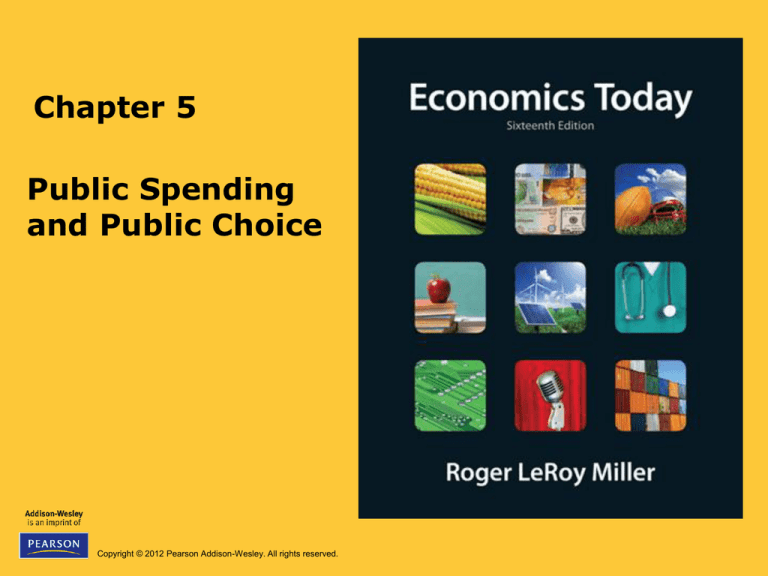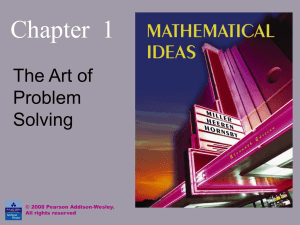
Chapter 5
Public Spending
and Public Choice
Copyright © 2012 Pearson Addison-Wesley. All rights reserved.
Introduction
The U.S. government plans to allocate $40 billion each
year to firms that specialize in “clean-energy”
technologies.
The government hopes that such technologies would
lead to fewer emissions entering the atmosphere.
What can we learn from economics about possible
ways in which the U.S. government might address
issues such as atmospheric pollution?
Copyright © 2012 Pearson Addison-Wesley. All rights reserved.
5-2
Learning Objectives
• Explain how market failures, such as
externalities, might justify economic
functions of government
• Distinguish between private and public
goods and explain the nature of the freerider problem
• Describe the political functions of
government that entail its involvement in
the economy
Copyright © 2012 Pearson Addison-Wesley. All rights reserved.
5-3
Learning Objectives (cont'd)
• Analyze how Medicare affects the
incentives to consume medical services
• Explain why increases in government
spending on public education have not
been associated with improvements in
measures of student performance
• Discuss the central elements of the theory
of public choice
Copyright © 2012 Pearson Addison-Wesley. All rights reserved.
5-4
Chapter Outline
• What a Price System Can and Cannot Do
• Correcting for Externalities
• The Other Economic Functions of
Government
• The Political Functions of Government
• Public Spending and Transfer Programs
• Collective Decision Making: The Theory of
Public Choice
Copyright © 2012 Pearson Addison-Wesley. All rights reserved.
5-5
Did You Know That ...
• The French Mediterranean island of Corsica has
about 10,000 stray cattle and pigs?
• Most of the stray animals are abandoned by
farmers after the elimination of agricultural
subsidies from the French government make it too
costly to keep maintain them in fenced lots.
• They constitute a spillover effect onto third parties
caused by the failure of Corsican farmers to take
into account the full costs of their actions.
Copyright © 2012 Pearson Addison-Wesley. All rights reserved.
5-6
What a Price System Can and
Cannot Do
• In its most ideal form, a price system
allows resources to move from lowervalued to higher-valued uses through
voluntary exchange
– Economic efficiency arises when all mutually
advantageous trades have taken place
• There are, however, situations when a
price system does not generate the
desired results
Copyright © 2012 Pearson Addison-Wesley. All rights reserved.
5-7
What a Price System Can and
Cannot Do (cont'd)
• Market Failure
– A situation in which the unrestrained market
economy leads to too few or too many
resources going to a specific economic activity
• Prevents economic efficiency and individual freedom
• Is addressed by public policy (government)
Copyright © 2012 Pearson Addison-Wesley. All rights reserved.
5-8
Correcting for Externalities
• In a pure market system, economic
efficiency occurs when individuals know
and must bear the true opportunity cost of
their actions
– In some cases, the price that someone actually
pays for a resource, good, or service is higher
or lower than the opportunity cost that all
society pays
Copyright © 2012 Pearson Addison-Wesley. All rights reserved.
5-9
Correcting for Externalities (cont'd)
• Market failure: an example
– Assume
• No government regulation against pollution
• A town with clean air
• A steel mill opens and emits smoke that causes
– More respiratory diseases
– Dirtier clothes, houses, cars
Copyright © 2012 Pearson Addison-Wesley. All rights reserved.
5-10
Correcting for Externalities (cont'd)
• Market failure: an example
– Market failure occurs
• Steel mill does not pay for the clean air
• Costs of production have “spilled over” to the
residents (third parties)
• Lower production cost
– More steel is produced than would otherwise be the
case
Copyright © 2012 Pearson Addison-Wesley. All rights reserved.
5-11
Correcting for Externalities (cont'd)
• Externalities
– Occur when the consequences of an economic
activity spill over to affect third parties
• Third Parties
– Parties who are not directly involved in a given
activity or transaction
• Property Rights
– Rights of an owner to use and exchange
property
Copyright © 2012 Pearson Addison-Wesley. All rights reserved.
5-12
Example: Space Age Litterbugs
• Littering in space has created at least 18,000
objects of orbiting space junk.
• After every space shuttle mission since 1981,
NASA has spent about $400,000 to replace the
shuttle’s debris-pitted windows.
• At least once each day, scientists issue warnings
of close encounters faced by orbiting commercial
satellites.
Copyright © 2012 Pearson Addison-Wesley. All rights reserved.
5-13
Correcting for Externalities (cont'd)
• Externalities are examples of market
failures
• Pollution is an example of a negative
externality
• Inoculations generate external benefits
Copyright © 2012 Pearson Addison-Wesley. All rights reserved.
5-14
Figure 5-1 External Costs and Benefits,
Panel (a)
Copyright © 2012 Pearson Addison-Wesley. All rights reserved.
5-15
Figure 5-1 External Costs and Benefits,
Panel (b)
Copyright © 2012 Pearson Addison-Wesley. All rights reserved.
5-16
Correcting for Externalities (cont’d)
• Resource misallocations of externalities
– External costs—market overallocates
– External benefits—market underallocates
• Government can correct negative
externalities
– Special taxes (i.e. a pollution tax or “effluent
fee”)
– Regulation
Copyright © 2012 Pearson Addison-Wesley. All rights reserved.
5-17
Correcting for Externalities (cont'd)
• How the government can correct positive
externalities
– Government financing and production
– Subsidies
– Regulation
Copyright © 2012 Pearson Addison-Wesley. All rights reserved.
5-18
The Other Economic Functions of
Government
• Providing a legal system
• Promoting competition
• Providing public goods
• Ensuring economy-wide stability
Copyright © 2012 Pearson Addison-Wesley. All rights reserved.
5-19
The Other Economic Functions of
Government (cont'd)
• Providing a legal system
– Enforcing contracts
– Defining and protecting property rights
– Establishing legal rules of behavior
Copyright © 2012 Pearson Addison-Wesley. All rights reserved.
5-20
The Other Economic Functions of
Government (cont'd)
• Promoting competition
– Market failure may occur if markets are not
competitive.
• Antitrust legislation
• Monopoly power
Copyright © 2012 Pearson Addison-Wesley. All rights reserved.
5-21
The Other Economic Functions of
Government (cont'd)
• Antitrust Legislation
– Laws that restrict the formation of monopolies
and regulate certain anticompetitive business
practices
• Monopoly
– A firm that can determine the market price, in
the extreme case is the only seller of a good or
service
Copyright © 2012 Pearson Addison-Wesley. All rights reserved.
5-22
The Other Economic Functions of
Government (cont'd)
• Providing public goods
– Goods to which the principle of rival
consumption does not apply
– In contrast, private goods can be consumed by
one individual at a time
Copyright © 2012 Pearson Addison-Wesley. All rights reserved.
5-23
The Other Economic Functions of
Government (cont'd)
• Principal of Rival Consumption
– Recognizes individuals are rivals in consuming
private goods
• Public Goods
– Can be jointly consumed by many individuals
simultaneously
Copyright © 2012 Pearson Addison-Wesley. All rights reserved.
5-24
The Other Economic Functions of
Government (cont'd)
• Characteristics of public goods
1. Can be used by more and more people at no
additional opportunity cost
2. Difficult to charge for a public good based on
consumption—the exclusion principle
Copyright © 2012 Pearson Addison-Wesley. All rights reserved.
5-25
Example: Countdown to Private Production of
Space Travel
• Increasingly more private firms, such as Armadillo
Aerospace, Blue Origin, and Virgin Galactic,
provide space-travel services in suborbital ships
that orbit around the earth.
• These space ships have a limited number of
seats, so that the services are not a public good
and they are subject to the principle of rival
consumption.
Copyright © 2012 Pearson Addison-Wesley. All rights reserved.
5-26
The Other Economic Functions of
Government (cont'd)
• Exclusion Principle
– Anyone can enjoy the benefits of a public good,
even if they have not paid for it
• Free-Rider Problem
– Arises when some individuals take advantage
of the fact that others will take on the burden
of paying for public goods
Copyright © 2012 Pearson Addison-Wesley. All rights reserved.
5-27
The Other Economic Functions of
Government (cont'd)
• Ensuring economy-wide stability
– Smooth ups and downs in overall business
activity
– Full Employment Act 1946
• Full employment
• Price stability
• Economic growth
Copyright © 2012 Pearson Addison-Wesley. All rights reserved.
5-28
The Political Functions of
Government
• Government-Sponsored Goods (Merit
Goods)
– Goods deemed socially desirable through the
political process
• Museums
• Government-Inhibited Goods (Demerit
Goods)
– Goods deemed socially undesirable
• Illegal substances
Copyright © 2012 Pearson Addison-Wesley. All rights reserved.
5-29
Why Not … classify broadband Internet
access as a government-sponsored good
and provide it to all U.S. residents?
• One problem with government provision of
broadband service to every U.S. resident is that
no one knows exactly what “broadband” means.
• A related problem is that the costs to taxpayers
depend heavily on the broadband speed,
especially for residents in rural areas.
Copyright © 2012 Pearson Addison-Wesley. All rights reserved.
5-30
The Political Functions of
Government (cont'd)
• Income redistribution: includes
progressive income tax system and
transfers
– Transfer payments
– Transfers in kind
Copyright © 2012 Pearson Addison-Wesley. All rights reserved.
5-31
The Political Functions of
Government (cont'd)
• Transfer Payments
– Money payments made by governments to
individuals for which in return no services or
goods are rendered
– Examples are Social Security old age and
disability benefits and unemployment insurance
benefits
Copyright © 2012 Pearson Addison-Wesley. All rights reserved.
5-32
The Political Functions of
Government
• Transfers in Kind
– Payments that are in the form of goods and
services
– Include food stamps, subsidized public housing,
medical care
Copyright © 2012 Pearson Addison-Wesley. All rights reserved.
5-33
Public Spending and Transfer
Programs
• Government Outlays
– All federal, state and local spending
– Examples
• Defense, income security, Social Security—at the
federal level
• Education, health and hospitals, public welfare—at the
state level
Copyright © 2012 Pearson Addison-Wesley. All rights reserved.
5-34
Figure 5-2 Total Government Outlays
over Time
Copyright © 2012 Pearson Addison-Wesley. All rights reserved.
5-35
Figure 5-3 Federal Government Spending Compared
to State and Local Spending
Copyright © 2012 Pearson Addison-Wesley. All rights reserved.
5-36
Public Spending and Transfer
Programs (cont'd)
• Publicly subsidized healthcare
– Medicare
• Began in 1965
• Pays hospital and physicians’ bills for U.S. residents
over 65 with public monies
• 2.9% of earnings taxed
• Second biggest domestic program in existence
– Medicaid
• Subsidizes people with lower incomes
Copyright © 2012 Pearson Addison-Wesley. All rights reserved.
5-37
Figure 5-4 The Economic Effects of
Medicare Subsidies
Copyright © 2012 Pearson Addison-Wesley. All rights reserved.
5-38
Public Spending and Transfer
Programs (cont’d)
• To increase the quantity of medical care,
the government pays a subsidy
– The price per unit paid to medical service
providers increases
– The price per unit paid by consumers falls
– More medical services are consumed
Copyright © 2012 Pearson Addison-Wesley. All rights reserved.
5-39
Policy Example: Seeking to Halt “Overuse” of
Massachusetts Health Care
• In 2006, the state of Massachusetts adopted a
program analogous to Medicare for all of its
residents.
• Within 3 years, health care spending for a typical
Massachusetts resident rose to 33 percent above
the average for other U.S. residents, mainly due to
the fact that the program “rewards overuse of
services.”
Copyright © 2012 Pearson Addison-Wesley. All rights reserved.
5-40
Public Spending and Transfer
Programs (cont’d)
• Economic Issues of Public Education
– State and local governments provide primary,
secondary, and post-secondary education at
prices well below those that would otherwise
prevail in the marketplace
– Publicly subsidized, similar to government
subsidized healthcare
– Education priced below market
Copyright © 2012 Pearson Addison-Wesley. All rights reserved.
5-41
Public Spending and Transfer
Programs (cont’d)
• The Incentive Problems of Public Education
– Various measures of performance show no
increase or decline in performance
– Many economists argue failure to improve
relies on incentive effects
– Higher subsidies may translate to services
unrelated to learning
Copyright © 2012 Pearson Addison-Wesley. All rights reserved.
5-42
Example: Valuable Charter School Services—for
Those Who Can Get Them
• Charter schools are stated-funded schools that
have the freedom to offer a variety of learning
approaches.
• Because many parents place higher values on the
educational services of charter schools and the
price of attending them is close to zero, the
quantity of charter school services demanded
exceeds the quantity supplied—hence the waiting
lists.
Copyright © 2012 Pearson Addison-Wesley. All rights reserved.
5-43
Collective Decision Making: The
Theory of Public Choice
• Collective Decision Making
– How voters, politicians, and other interested
parties act and how these actions influence
non-market decisions
Copyright © 2012 Pearson Addison-Wesley. All rights reserved.
5-44
Collective Decision Making: The Theory of
Public Choice (cont'd)
• Theory of Public Choice
– The study of collective decision making
– Assumes that individuals will act within the
political process to maximize their individual
(not collective) well-being
Copyright © 2012 Pearson Addison-Wesley. All rights reserved.
5-45
Collective Decision Making: The Theory of
Public Choice (cont'd)
• Similarities in market and public-sector
decision making
– Self-interest
– Opportunity cost
– Competition
– Similarity of individuals, but different incentive
structures
Copyright © 2012 Pearson Addison-Wesley. All rights reserved.
5-46
Collective Decision Making: The Theory of
Public Choice (cont'd)
• Incentive Structure
– The system of rewards and punishments
individuals face with respect to their
actions
Copyright © 2012 Pearson Addison-Wesley. All rights reserved.
5-47
Collective Decision Making: The Theory of
Public Choice (cont'd)
• Differences between market and collective
decision making
– Government goods at zero price
– Use of force
– Voting versus spending
Copyright © 2012 Pearson Addison-Wesley. All rights reserved.
5-48
Collective Decision Making: The Theory of
Public Choice (cont'd)
• Differences between market and collective
decision making
– Voting versus spending
• Political system versus market system
– Political system run by majority rule
– Market system run by proportional rule
Copyright © 2012 Pearson Addison-Wesley. All rights reserved.
5-49
Collective Decision Making: The Theory of
Public Choice (cont'd)
• Government or Political Goods
– Goods (and services) provided by the public
sector
• Majority Rule
– Collective decision making, decisions based on
more than 50%
• Proportional Rule
– If 10% of “dollar votes” cast for blue cars, 10%
of output is blue
Copyright © 2012 Pearson Addison-Wesley. All rights reserved.
5-50
Collective Decision Making: The Theory of
Public Choice (cont'd)
• Differences between market and collective
decision making
– Voting versus spending
• Spending of dollars can indicate intensity of want
• Votes cannot; each vote counts with the same
intensity
Copyright © 2012 Pearson Addison-Wesley. All rights reserved.
5-51
International Example: So Little Mail, So Little
for So Many Post Offices to Do
• As more people around the world transmit
information via e-mail instead of physical letters
and other documents, government-owned postal
firms experience declines in mail volume.
• Even though governments have been reducing the
number of post offices they operates, they have
been much slower to scale back their postal firms
than if the firms were operated privately.
Copyright © 2012 Pearson Addison-Wesley. All rights reserved.
5-52
You Are There: A Town Confronts a Parked
Externality
• In New Castle, Indiana, a resident lines some
railroad tracks with dozens of yellow railcars
covered with graffiti and marijuana leaves.
• Those railcars are an eyesore to the community’s
residents—a negative spillover from the market
for rail transport services.
Copyright © 2012 Pearson Addison-Wesley. All rights reserved.
5-53
Issues & Applications: Uncle Sam Becomes
an Investor in Clean-Energy Technology
• The U.S. Department of Energy has announced
that it would give away over $40 billion annually
to businesses working on “clean technology.”
• Some key recipients of the program are
manufacturers of electric vehicles, such as
General Motors and Ford Motor Company.
• One difficulty with those vehicles is that the
technology for charging vehicles’ batteries is still
undeveloped.
• Another difficulty is that the production of those
batteries is not clean, even though those vehicles
may be clean.
Copyright © 2012 Pearson Addison-Wesley. All rights reserved.
5-54
Summary Discussion of Learning
Objectives
• How market failures such as externalities might
justify economic functions of government
– Market failure is a situation in which an unhindered free
market allocates too many or too few resources to a
specific economic activity
• Private goods versus public goods and the freerider problem
– Private goods are subject to rival consumption
– Public goods are not subject to rival consumption
– Free-riders anticipate others will pay
Copyright © 2012 Pearson Addison-Wesley. All rights reserved.
5-55
Summary Discussion of Learning
Objectives (cont'd)
• Political functions of government that lead
to its involvement in the economy
– Merit goods deemed socially desirable
– Demerit goods deemed socially undesirable
– Redistributing income
• Transfer payments
• In kind transfers
Copyright © 2012 Pearson Addison-Wesley. All rights reserved.
5-56
Summary Discussion of Learning
Objectives (cont'd)
• The effect of Medicare on incentives to
consume medical services
– Subsidies lead to a higher quantity of medical
services consumed
– Medicare encourages people to consume
medical services that are low in per-unit value
relative to the cost
Copyright © 2012 Pearson Addison-Wesley. All rights reserved.
5-57
Summary Discussion of Learning
Objectives (cont'd)
• Why bigger subsidies for public schools do
not necessarily translate into improved
student performance
– Last unit of educational services provided likely
to cost more than its valuation by parents and
students
– Services provided in excess of those best
suited to promoting student learning
Copyright © 2012 Pearson Addison-Wesley. All rights reserved.
5-58
Summary Discussion of Learning
Objectives (cont'd)
• Central elements of the theory of public choice
– Collective decision making
• Voters, politicians, other participants influence nonmarket
choices
– Incentive structures
• Rewards and punishments affect provision of government
goods
– Similarities and differences with market system
structures
• Scarcity, competition—similarities
• Legal coercion, majority rule—differences
Copyright © 2012 Pearson Addison-Wesley. All rights reserved.
5-59







